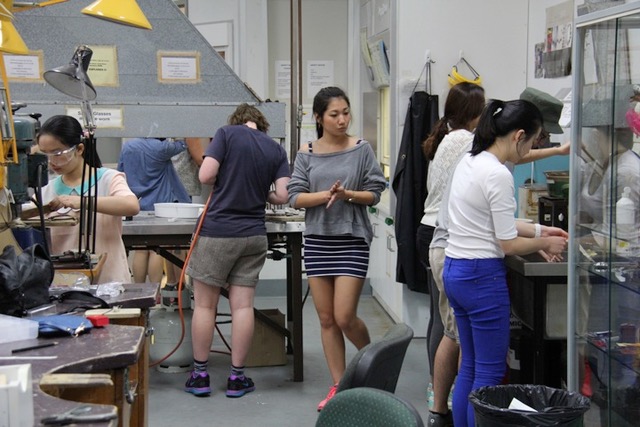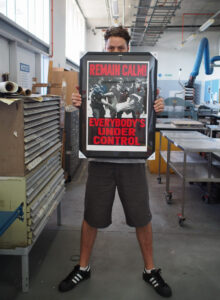
Seth Ellis argues that crafts are an essential part of university education, but they need to become more connected with other disciplines.
I’m a senior lecturer in interactive media at Queensland College of Art, part of Griffith. My perspective on craft-based tertiary education is thus as a sympathetic observer, unless you count coding and technology as crafts, which personally I’d like to do. In any case, I’m starting out with these things as understood:
- Physical crafts are now very popular, in reaction to the increased digitisation of everything—but this explosion is happening alongside the digitisation of everything, rather than one thing replacing the other;
- Craft-based disciplines are often, though not always, repositories of cultural traditions that deserve not just safeguarding, but productive ways forward.
My own attitude is that arguing in defence of craft-based education is good for creative practice in tertiary education as a whole, for reasons I’ll explain below.
The first thing to note is just how centralised university bureaucracy has become, which I think many people outside the system (including students) aren’t quite aware of. At Griffith University, courses are not timetabled—that is, assigned certain rooms at certain times—by the individual school, but by Griffith centrally. The timetabling is largely automated, with the intent of rolling over from one year to the next. The various differentiations of course types are not very sophisticated; the uni’s mechanisms don’t really understand the difference between “tutorial”, “studio,” “lab”, and so forth. This has implications for workload and sessional pay—studio hours don’t pay as much as tutorial hours, because they are assumed to involve no prep time—as well as the types of spaces assigned. Thus, on the one hand, one of my digital-based courses was once timetabled into the goldsmithing studio, because I labelled it a “studio.” On the other hand, our newly renovated Design spaces are tagged as “tutorial” and “lecture” spaces, so we sometimes get art history lectures or even business seminars in there.
In other words, the trend is towards generic teaching spaces and centralised, automated control. Specialised craft spaces are of course not consistent with this trend. Historically, craft courses and workshops have simply indicated that they won’t play ball with these trends, and that’s that. In my observation, these educators have been canny navigators of university bureaucracy in the past; they’re used to flying under the radar. But part of the effect of increasing centralised control is that there is no under-the-radar any more. In our current situation, I very seriously doubt the Directors of the art schools at Griffith and ANU had much or any presence in the decision-making process. Every program is open to scrutiny, and importantly, to the same scrutiny across the university. Courses in literature, in biology, and in jewellery and small objects are judged on the same criteria.
Because of the current state of arts and education funding in Australia, these criteria are largely, and increasingly, financial. For some years, academics have been under pressure to “find efficiencies” in the ways we teach, and this pressure has only accelerated in growth in the current pandemic-inspired budget crisis. In my part of Design, where we teach with computers, we’ve seen our enrolment caps creep up, our courses scheduled in a variety of fairly generic spaces, et cetera. But this is still inconsistent with best-practice studio education, whatever’s being done in the studio. Project-based learning can’t be done fully without one-on-one, non-goal-oriented communication both between student and teacher and between students amongst themselves. This is one reason why, when physical crafts lose their place in education, all creative practices lose, sooner or later.
Another reason, for me, is that the definition of “craft” deserves a wider definition in the current creative ecology. For me, coding is a craft, and would benefit from being treated that way, as something that’s capable of being beautiful, and not just dull and utile. Also, though, in my considerable experience, it’s easiest to teach even code in physical proximity with students, because you’re all working on the same project together in the same space. Studio education models education as a community endeavour, which is the primary reason for all creative-practice practitioners—indeed, all academics—to fight for it.
However, the economic fact is that physical craft disciplines can’t work in isolation any more. As I said above, historically, craft-based educators have tended to hold themselves aloof from the commercialising aspects of the university as a whole, because those disciplines just can’t do that by nature. You can’t fit 30 people in the room, let alone educate them well. But this built-in resistance has now become an existential liability.
In short, craft-based disciplines need other disciplines to be actively involved in their work and vice versa. It’s my very strong belief that unless all creative disciplines hang together in very concrete, even curricular ways, we’re all screwed in various ways. Further, though, I think these ties should be about creative practice per se, and not putative ties to industry. Craft-based disciplines like jewellery and small objects have been pulling away from industrial work for some time, in favour of the entrepreneurial single creator, and I think that’s a strength to be capitalised on.
This is my personal observation, but I think that some craft-based educators have passed by some opportunities to make those deep ties with other disciplines over the past few years. I know many colleagues (at Griffith and elsewhere) who will say that when Design students find their courses, they love them, and this is true. But those courses have to be found, by individual students, like hidden treasures. Craft disciplines can no longer hang back in their purity and wait for people to appreciate them. Proactive deep ties between disciplines need to be made now, not just because those ties are there to be made on aesthetic levels—ask me later for my opinion of the historically contingent, arbitrary differences between “art,” “design,” and “craft”—but for sheer survival in the current dire circumstances in education. Now we have to make those ties in a hurry, if we have time. But that’s what I see as the way forward, to safeguard existing strengths by entangling them with other disciplines so that all disciplines are demonstrably necessary to each other.
For a specific example, there’s the (current lack of) relationship at Griffith between Printmaking, which is in Fine Art, and Visual Communications, which is in Design. Printmaking has a letterpress; VisCom teaches typography; but there is no curricular overlap between them. Typography and the letterpress never intersect, even though they happen in adjoining buildings. The results are Fine Art letterpress works that make our type designers cringe a bit sometimes, and burgeoning type designers who are learning about the history of type without ever seeing movable type in person. This is all objectively a bit silly, but it’s how the programs evolved. I’ve heard students in Fine Art talk about the “cool toys” in Design (laser cutters, 3D printers) as unavailable luxuries, and Design students literally be afraid to walk into the woodshop for fear of being treated like outsiders. I hear stories of Fine Art students in their capstone projects painfully trying to teach themselves simple interactive technologies that I could explain to them in a few hours. Those divisions aren’t real, but the perception of them is, and that needs conscious intervention to be overcome. In this case, the immediate solution seems fairly evident on a curricular level: make Printmaking and VisCom courses electives in each others’ majors.
In my opinion, an expanded idea of “craft” to mean “a focus on material and tools for their own sake,” whatever those materials and tools and whatever the purpose and outcome, would do a lot of benefit for our students, strengthen ties between disciplines, and end us up in a stronger position to protect ourselves from the bureaucracy. We should understand our various disciplines to be additive in the aggregate, and argue for them on that basis, rather than worry that one discipline will replace another. Otherwise, in the current economic climate, we will all slowly be ground away.
The recent student/alumni protests at Griffith have been great for pointing out that closing these historically important workshops at the Queensland College of Art will be embarrassing for Griffith. In our particular case, this needs to be accompanied by a solid case for how to survive economically, or Griffith will put up with the embarrassment and pull the plug anyway. We all know how difficult it is to restart these workshops when they’ve gone defunct. In addition, we need to prep ourselves now for the next round of proposed cuts. As I said earlier, I see the same sad trends happening to less physically involved disciplines, but more slowly. I think we need a) to show solidarity with each others’ disciplines, to protect us all from increasing cost-cutting, and b) to deeply engage with each others’ disciplines, at least for our undergrads, so that no one discipline can be isolated and lopped off.
Seth Ellis is a Senior Lecturer at the Queensland College of Arts, Griffith University.



